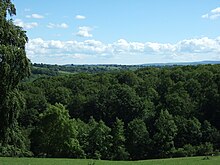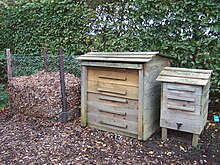A soil scientist examines horizons within the soil profile
Soil science is the study of soil as a natural resource on the surface of the Earth including soil formation, classification
and mapping; physical, chemical, biological, and fertility properties
of soils; and these properties in relation to the use and management of soils.
Sometimes terms which refer to branches of soil science, such as pedology (formation, chemistry, morphology, and classification of soil) and edaphology
(how soils interact with living things, especially plants), are used as
if synonymous with soil science. The diversity of names associated
with this discipline is related to the various associations concerned.
Indeed, engineers, agronomists, chemists, geologists, physical geographers, ecologists, biologists, microbiologists, silviculturists, sanitarians, archaeologists, and specialists in regional planning, all contribute to further knowledge of soils and the advancement of the soil sciences.
Soil scientists have raised concerns about how to preserve soil
and arable land in a world with a growing population, possible future water crisis, increasing per capita food consumption, and land degradation.
Fields of study
Soil occupies the pedosphere, one of Earth's spheres that the geosciences use to organize the Earth conceptually. This is the conceptual perspective of pedology and edaphology,
the two main branches of soil science. Pedology is the study of soil in
its natural setting. Edaphology is the study of soil in relation to
soil-dependent uses. Both branches apply a combination of soil physics, soil chemistry, and soil biology. Due to the numerous interactions between the biosphere, atmosphere and hydrosphere
that are hosted within the pedosphere, more integrated, less
soil-centric concepts are also valuable. Many concepts essential to
understanding soil come from individuals not identifiable strictly as
soil scientists. This highlights the interdisciplinary nature of soil concepts.
Research
Dependence
on and curiosity about soil, exploring the diversity and dynamics of
this resource continues to yield fresh discoveries and insights. New
avenues of soil research are compelled by a need to understand soil in
the context of climate change, greenhouse gases, and carbon sequestration. Interest in maintaining the planet's biodiversity and in exploring past cultures has also stimulated renewed interest in achieving a more refined understanding of soil.
Mapping
Most empirical knowledge of soil in nature comes from soil survey efforts. Soil survey, or soil mapping, is the process of determining the soil types
or other properties of the soil cover over a landscape, and mapping
them for others to understand and use. It relies heavily on
distinguishing the individual influences of the five classic soil
forming factors. This effort draws upon geomorphology, physical geography,
and analysis of vegetation and land-use patterns. Primary data for the
soil survey are acquired by field sampling and supported by remote sensing.
Classification
Map of global soil regions from the USDA
As of 2006, the World Reference Base for Soil Resources, via its Land & Water Development division, is the pre-eminent soil classification system. It replaces the previous FAO soil classification.
The WRB borrows from modern soil classification concepts, including USDA soil taxonomy. The classification is based mainly on soil morphology as an expression pedogenesis. A major difference with USDA soil taxonomy is that soil climate is not part of the system, except insofar as climate influences soil profile characteristics.
Many other classification schemes exist, including vernacular
systems. The structure in vernacular systems are either nominal, giving
unique names to soils or landscapes, or descriptive, naming soils by
their characteristics such as red, hot, fat, or sandy. Soils are
distinguished by obvious characteristics, such as physical appearance
(e.g., color, texture, landscape position), performance (e.g.,
production capability, flooding), and accompanying vegetation. A vernacular distinction familiar to many is classifying texture
as heavy or light. Light soil content and better structure, take less
effort to turn and cultivate. Contrary to popular belief, light soils do
not weigh less than heavy soils on an air dry basis nor do they have
more porosity.
History
Contemporaries Friedrich Albert Fallou, the German founder of modern soil science, and Vasily Dokuchaev,
the Russian founder of modern soil science, are both credited with
being among the first to identify soil as a resource whose distinctness
and complexity deserved to be separated conceptually from geology and
crop production and treated as a whole. As a founding father of soil
science Fallou has primacy in time. Fallou was working on the origins of
soil before Dokuchaev was born, however Dokuchaev's work was more
extensive and is considered to be the more significant to modern soil
theory than Fallou's.
Previously, soil had been considered a product of chemical transformations of rocks, a dead substrate from which plants derive nutritious elements. Soil and bedrock were in fact equated. Dokuchaev considers the soil as a natural body having its own genesis and its own history of development, a body with complex and multiform processes taking place within it. The soil is considered as different from bedrock. The latter becomes soil under the influence of a series of soil-formation factors (climate, vegetation, country, relief and age). According to him, soil should be called the "daily" or outward horizons of rocks regardless of the type; they are changed naturally by the common effect of water, air and various kinds of living and dead organisms.
A 1914 encyclopedic definition: "the different forms of earth on the
surface of the rocks, formed by the breaking down or weathering of
rocks".
serves to illustrate the historic view of soil which persisted from the
19th century. Dokuchaev's late 19th century soil concept developed in
the 20th century to one of soil as earthy material that has been altered
by living processes. A corollary concept is that soil without a living component is simply a part of earth's outer layer.
Further refinement of the soil concept is occurring in view of an
appreciation of energy transport and transformation within soil. The
term is popularly applied to the material on the surface of the Earth's moon
and Mars, a usage acceptable within a portion of the scientific
community. Accurate to this modern understanding of soil is Nikiforoff's
1959 definition of soil as the "excited skin of the sub aerial part of
the earth's crust".
Areas of practice
Academically, soil scientists tend to be drawn to one of five areas of specialization: microbiology, pedology, edaphology, physics, or chemistry.
Yet the work specifics are very much dictated by the challenges facing
our civilization's desire to sustain the land that supports it, and the
distinctions between the sub-disciplines of soil science often blur in
the process. Soil science professionals commonly stay current in soil
chemistry, soil physics, soil microbiology, pedology, and applied soil
science in related disciplines.
One interesting effort drawing in soil scientists in the USA as of 2004
is the Soil Quality Initiative. Central to the Soil Quality Initiative
is developing indices of soil health and then monitoring them in a way
that gives us long term (decade-to-decade) feedback on our performance
as stewards of the planet. The effort includes understanding the
functions of soil microbiotic crusts and exploring the potential to
sequester atmospheric carbon in soil organic matter.
The concept of soil quality, however, has not been without its share of
controversy and criticism, including critiques by Nobel Laureate Norman Borlaug and World Food Prize Winner Pedro Sanchez.
A more traditional role for soil scientists has been to map soils. Most every area in the United States now has a published soil survey,
which includes interpretive tables as to how soil properties support or
limit activities and uses. An internationally accepted soil taxonomy
allows uniform communication of soil characteristics and soil functions.
National and international soil survey efforts have given the
profession unique insights into landscape scale functions. The landscape
functions that soil scientists are called upon to address in the field
seem to fall roughly into six areas:
- Land-based treatment of wastes
- Septic system
- Manure
- Municipal biosolids
- Food and fiber processing waste
- Identification and protection of environmentally critical areas
- Sensitive and unstable soils
- Wetlands
- Unique soil situations that support valuable habitat, and ecosystem diversity
- Management for optimum land productivity
- Silviculture
- Agronomy
- Native vegetation
- Grazing
- Management for optimum water quality
- Stormwater management
- Sediment and erosion control
- Remediation and restoration of damaged lands
- Mine reclamation
- Flood and storm damage
- Contamination
- Sustainability of desired uses
There are also practical applications of soil science that might not be apparent from looking at a published soil survey.
- Radiometric dating: specifically a knowledge of local pedology is used to date prior activity at the site
- Stratification (archeology) where soil formation processes and preservative qualities can inform the study of archaeological sites
- Geological phenomena
- Altering soils to achieve new uses
- Vitrification to contain radioactive wastes
- Enhancing soil microbial capabilities in degrading contaminants (bioremediation).
- Carbon sequestration
- Environmental soil science
- Pedology
- Soil genesis
- Pedometrics
- Soil morphology
- Soil micromorphology
- Soil classification
- Soil biology
- Soil chemistry
- Soil biochemistry
- Soil mineralogy
- Soil physics
- Pedotransfer function
- Soil mechanics and engineering
- Soil hydrology, hydropedology
Fields of application in soil science
- Climate change
- Ecosystem studies
- Pedotransfer function
- Soil fertility / Nutrient management
- Soil management
- Soil survey
- Standard methods of analysis
- Watershed and wetland studies
Related disciplines
- Agricultural sciences
- Agricultural soil science
- Agrophysics science
- Irrigation management
- Anthropology
- Environmental science
- Physical geography
- Geology
- Hydrology
- Waste management
- Wetland science
Depression storage capacity
Depression
storage capacity, in soil science, is the ability of a particular area
of land to retain water in its pits and depressions, thus preventing it
from flowing. Depression storage capacity, along with infiltration capacity, is one of the main factors involved in Horton overland flow,
whereby water volume surpasses both infiltration and depression storage
capacity and begins to flow horizontally across land, possibly leading
to flooding and soil erosion. The study of land's depression storage capacity is important in the fields of geology, ecology, and especially hydrology.



















